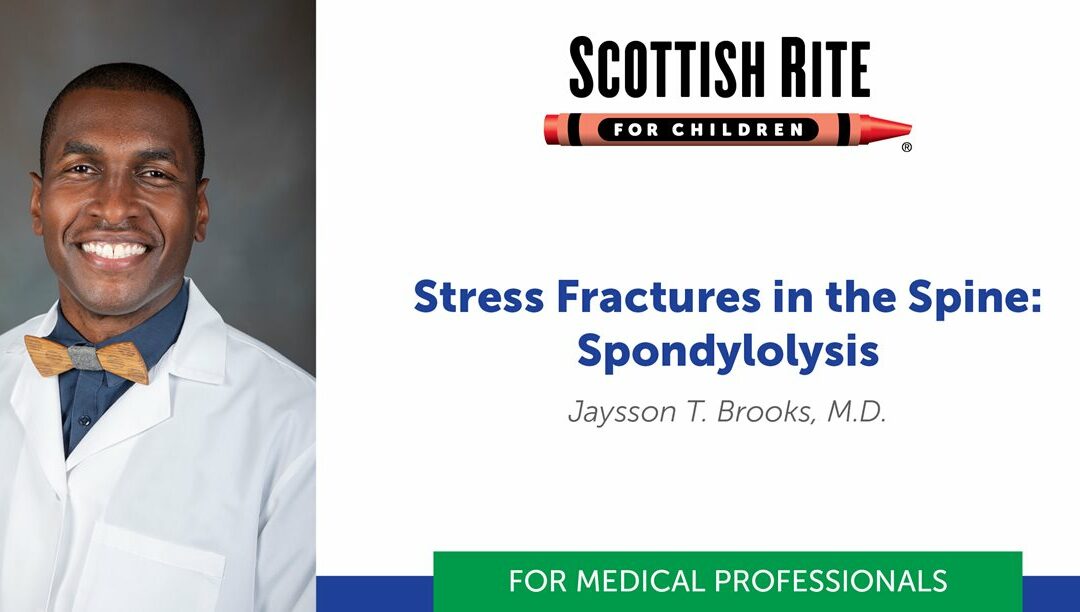Pediatric orthopedic surgeon Jaysson T. Brooks, M.D., presented this as part of Coffee, Kids and Orthopedics education series. Brooks provided a detailed discussion of evaluating stress fractures in the spines of adolescents.
You can and print the pdf.
watch the full lecture -What is Spondylolysis?
The facet joints in the back of the spine are connected by small segments of bone called pars interarticularis. Since this portion of the spine doesn’t get a great blood supply, it is at risk for stress fractures. This condition is called spondylolysis. Spondylolysis occurs more commonly at the L5 level and less commonly at the L4 level.
Most kids aren’t born with spondylolysis; it is caused by overuse and repetitive mechanical stress or forces. Activities or sports with repetitive hyperextension can cause a stress fracture of the spine. We see a higher incidence of spondylolysis in adolescents – as many as 47% of those with back pain. This is typically higher during growth spurts. The condition is much less frequent in adults. Some estimate 5% of adults with low back pain have spondylolysis.
In some cases, the stress fracture occurs bilaterally and the vertebra can slip forward, which is called spondylolisthesis. If a slipped vertebra presses on a nerve, it might cause severe shooting pain down the leg, and surgery may be required. However, if it breaks and doesn’t slip forward, surgery might not be necessary.
Spondylolysis: Genetic Predisposition?
- Spondylolysis occurs in 15-70% of first-degree relatives
- Prevalence
- White: 6%
- Black: 2-3%
- Indigenous American (Inuit): as high as 40%
History Matters
There is a higher prevalence of spondylolysis in elite athletes who report playing sports with repetitive hyperextension/rotation of the lumbar spine. Back pain should raise suspicion in these athletes:
- Football lineman
- Cheerleaders
- Gymnasts
- Weightlifters
- Divers / Swimmers
Back pain without a history of injury or repetitive activities is less likely to be caused by a stress fracture. In cases with shooting or decentralized pain, disc herniation should be considered.
Exam
The physical exam to assess for a stress fracture begins with palpation, and pain should be centralized around L5-S1 area. Active extension and hyperextension will be more painful than flexion. Coordination and strength should not be affected unless there is some nerve involvement, but pain may impact their ability to perform activities like heel walking and single leg hopping.
Imaging
In most cases, especially if the patient heard a “pop” and has acute low back pain, a standing anterior-posterior (AP) and lateral X-ray of the lower lumbar spine is recommended.
A study published in the Journal of Pediatric Orthopaedics looked at 2,846 patients with a median age of 14.6 years that were seen for back pain. 76% had no clear cause for their back pain, and less than 61% had two or fewer follow-up visits. This is a good reminder that not every patient with back pain has a stress fracture.
X-rays may not show early signs of spondylolysis. Rather than automatically ordering advanced imaging, a pediatric sports or spine referral may be the best next step because MRIs may also be inconclusive.
Treatment
Treat conservatively first.
- Activity Modification: 3 – 6 months
- Physical Therapy: 3 – 6 months
- Focus on core strengthening to improve lumbar stability
- Non-steroidal anti-inflammatory drugs (NSAIDS)
- Meloxicam and/or diclofenac cream
- Naproxen
- Bracing may provide comfort but does not affect return to activities.
Often patients only want to do one of these, but that may make extend their recovery by several months.
It is acceptable if a fracture never heals on an X-ray as long as the symptoms go away. If six months of conservative treatments only show slight improvements, a pars injection may help their symptoms. Some patients are injected every six months.
Surgery should always be a last resort.
If the gap is not too wide, a screw is used for a direct pars interarticularis repair. A fusion of the surrounding vertebra may be considered if a loss of motion is acceptable.
Check out our latest on-demand lectures available for medical professionals.

